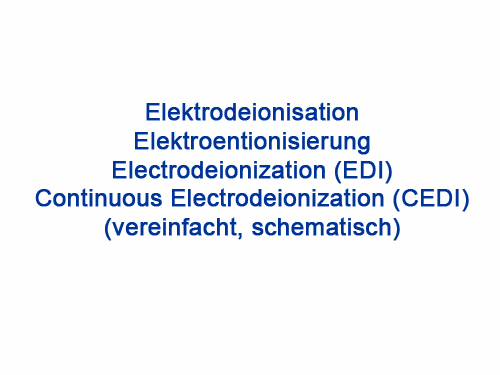Electrodeionization
The electrodeionization is an electrochemical process for broadest removal of ions and ionizable substances from water . It is a combination of ion exchange and electrodialysis . The central component of a water treatment system in this process is the so-called EDI module, in which the electrodeionization takes place.
These systems are used as the final treatment stage for the production of ultrapure water , for example for the pharmaceutical or semiconductor industry. The systems operated with appropriately prepared water achieve an electrical conductivity below 6 · 10 −6 S / m as a treatment result .
Mode of operation and structure of the EDI module
The prepared water (state of the art: conductivity less than 2 mS / m) flows continuously into the module. Salt-free water (diluate) is produced there by removing the remaining ingredients. The substances previously contained are released in dissolved form as waste water (concentrate).
Within the EDI module, the water flows perpendicular to the electrical field in the module through chambers, each delimited by an anion exchange membrane (AAT) and a cation exchange membrane (KAT) and filled with a mixed-bed ion exchanger (MB, a combination of anion and cation exchange resin) are.
The electrical field causes the ions to migrate to the respective electrode. The exchanger membranes allow the passage of z. B. anions, while cations are prevented from penetrating. In this way a concentration of the ions in the concentrate compartment (KR) is achieved. At the same time, some of the water molecules dissociate under the influence of the electric field . This causes the mixed-bed exchanger resin to regenerate itself and allows continuous and chemical-free operation.
literature
- Klaus Ohlrogge, Katrin Ebert: Membranes: Fundamentals, Processes and Industrial Applications . Wiley-VCH, 2006, ISBN 3-527-30979-9
Individual evidence
- ↑ How Does CEDI Work? Ionpure video
- ^ Rudolf Voigt, Alfred Fahr : Pharmaceutical technology . 11th edition. S. 140, Deutscher Apotheker Verlag, Stuttgart 2010, ISBN 978-3-7692-5003-9 .

